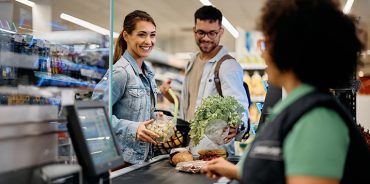Tackling online grocery’s profitability problem
With online grocery surging as a result of the pandemic, Retailers around the world are now facing up to a new challenge: making ecommerce profitable. In the first in a two-part series, Dave Clements discusses the online profitability conundrum and why a focus on operational efficiency can help to offset the cost of fulfilment.
The explosive growth seen in online grocery over the past year and a half has already been well documented – not only within the industry, but across the media as a whole. In the unlikely event that you haven’t been keeping up with this rapidly shifting dynamic, suffice to say that Customer adoption of the online channel looks unlikely to revert back to pre-pandemic levels, something that we posited in our own “Grocery Beyond the Tipping Point” report last year.
From an outsider’s point of view, it would be reasonable to assume that this is a net positive for the grocery industry. After all, more sales means more money – doesn’t it? The reality, as anyone with knowledge of the complex mechanisms at play here, is very different indeed.
While the pandemic has served to exponentially increase demand for online grocery, for many Retailers that surge in adoption will only have place an additional burden on a model that was already under strain. The average picking fee for an online order sits at around €15 according to some sources¹, meaning that Retailers can face an operating margin of up to -10% on those deliveries. They may be selling “more”, but many grocery businesses are paying a very real price for doing so.
Ever eager to explore the impact that changes in shopper behaviours can have on the Retail industry, the question of how to make online grocery profitable is one that we’ve been contemplating for some time at dunnhumby. From our perspective, the potential solutions to this immense task can be divided into two quite different categories: operational optimisation, and alternative revenue streams.
The creation of alternative revenue streams – and how they can help in the fight to make online profitable – is something that we’ll look at in the next post in this series. For now, let’s consider how Retailers can leverage operational optimisation as a way to build more efficient and effective ecommerce offerings.
Gauging maturity in six key areas
When evaluating a Retailer’s ecommerce capabilities, we tend to explore their relative maturity across six dimensions. The better their cumulative performance across all six, the more likely it is that their online operations will be efficient, scalable, and ultimately profitable. Let’s look at each of those areas.
- Connected Data
“Connected” is the key word here. To gain genuine understanding into Customer needs and behaviours – and thus predict shifts in demand – Retailers need connected datasets that provide a 360° view across channels, devices, and touchpoints both online and off.
- Customer Strategy and Insight
Maturity here is best defined by the extent to which a Retailer has built an online proposition that fulfils their Customers’ needs. This means being able to understand which Customers are using the channel, how their shopping missions vary, and the “halo” effect delivered by different Customer segments.
- Customer Lifecycle and Personalisation
How effectively does a Retailer drive ecommerce adoption? How well can they identify and target strategic Customers? And how capable are they of driving spend by delivering relevant, personalised communications? All three factors are vital in this area.
- Fulfilment and Operations
While advanced maturity in this field tends to be signalled by the application of data, technology, and robotics to picking and fulfilment, the interim priority for any Retailer should be on ensuring that their approach is as scalable and efficient as possible.
The primary focus around product and category management should be on knowing whether online channels are over- or underperforming against in-store – and why. And, just as Retailers optimise in-store flow, the same rationale needs to be applied to search and category display online.
An area that we’ll discuss more in the next post on alternative revenue streams, greater maturity here can help Retailers drive sales and increase basket sizes, as well as offset the cost of ecommerce through monetisable media and insights.
While a Retailer’s level of maturity in each of these areas helps us understand how efficient – and hence profitable – its online offering is likely to be, just about any grocery business is likely to benefit from focusing on optimising some of the foundational aspects of ecommerce too. We see these as follows:
- Basket sizes
The bigger the overall basket, the more profitable a shop is likely to be. dunnhumby has found that relevant digital shopping experiences can boost basket sizes by between 10% and 20%.
- Picking
Planograms, substitutability science, and micro-fulfilment in large stores can all serve as effective stopgap solutions on the road to a bigger transformation in the form of fully automated picking.
- Delivery
Nudging shoppers towards click-and-collect options in favour of home delivery can help to rebalance the cost of ecommerce. Delivery subscriptions can help to lock in frequency and spend, while partnerships with last mile fulfilment companies may aid in the pursuit of profitability.
- Retention
If a Customer moves to a competing Retailer, they may take more than their online shop with them. Ensuring that existing shoppers stay loyal is ultimately more cost effective than winning new ones.
All of these issues – and more – are discussed in detail in The Route to Online Profitability, a new dunnhumby report that explores the economics of growth in ecommerce. A free copy of the report can be downloaded from our resources section here.
As well as operational efficiency, The Route to Online Profitability also looks in-depth at the growing need for Retailers to create alternative revenue streams. It’s that subject that I’ll be turning my attention to in my next post.
¹Why supermarkets are struggling to profit from the online grocery boom – The Financial Times, 23rd July 2020
RELATED PRODUCTS
Improve CPG collaboration and turn insight into commercial opportunity
Read moreThe latest insights from our experts around the world



